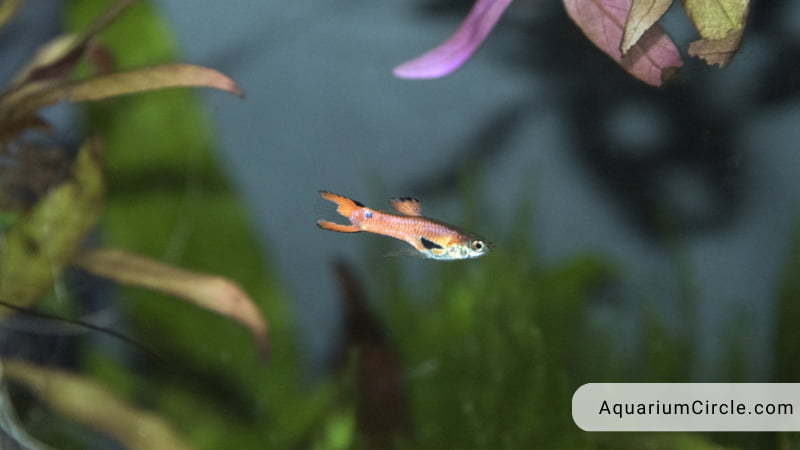Welcome to our comprehensive guide exploring the fascinating world of guppies! As one of the most popular freshwater aquarium fish, guppies are cherished for their vibrant colors, hardy nature, and easy care requirements. But, as a guppy owner or enthusiast, one question you might have is, “how big do guppies get?”
Guppies typically reach an adult size of 1.5 to 2.4 inches (3.8 to 6 cm), with males being smaller than females. Their growth is influenced by factors such as genetics, diet, and water quality.
Understanding the size and growth patterns of guppies is crucial to providing them with the best possible care and environment. In this guide, we will delve into the factors that influence guppy size, typical growth patterns, and tips to ensure your guppies grow healthy and strong. So, let’s dive in and uncover the answer to this essential question.
See also:
- Guppy Fish Male And Female Are Easy To Identify: Ways To Know Them
- How Do Guppies Mate – Breeding Time, Care For Fry Guppy Fish
- 5 Easy Tricks To Tell Female Guppy Fish From Males
How Big Do Guppies Get?
Guppy fish, also known as rainbow fish or million fish, originating from northeast South America. However, they have successfully adapted and can now be found worldwide, even in harsh environmental conditions. Guppies primarily feed on invertebrates, diatoms, mineral particles, plant fragments, aquatic insect larvae, and algal remains, with the latter making up a significant portion of their diet. Their diet can vary depending on environmental conditions and food availability. Guppies are often used as model organisms in evolutionary and ecological studies.
To ensure the healthy growth of guppy fish, it is essential to provide proper water conditions, adequate space, and high-quality food. While genetic factors play a major role in their growth, external factors also contribute. Size differences exist between male and female guppies, with males typically growing to 0.6-1.4 inches long (1.5-3.5 cm) and females reaching 1.2-2.4 inches (3-6 cm). Jumbo guppies, which can grow up to 5 inches long (12.7 cm), are considered an exception. Male guppies are usually measured after seven weeks, while female guppies continue reproducing until 22-34 months of age. A single tank can comfortably accommodate and feed three to five guppies.
How Big Do Baby Guppies Grow?
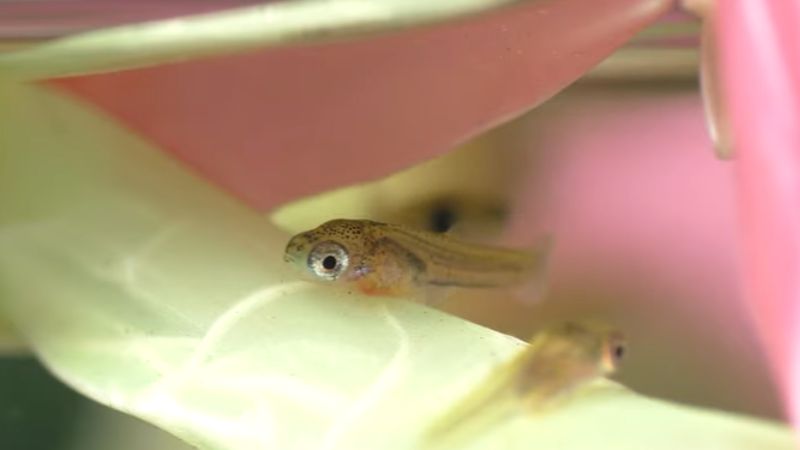
Guppy fry reach maturity within a period of approximately 2 to 3 months. At the time of birth, their size ranges from 1/4 to 3/4 inches (1.2 to 2 cm) in length. Under optimal conditions, these juvenile guppies may experience substantial growth, attaining a length of approximately an inch within their first month. At this stage, they typically exhibit a slender appearance and lack the vibrant coloration characteristic of adult guppies.
Nonetheless, after a period of 30 to 40 days, these juvenile fish begin to display the development of their unique color patterns, which can be observed with daily changes. Concurrently, they become capable of reproduction. Upon reaching the age of 2 months or slightly beyond, the guppy fry will have fully matured into adult specimens.
When Will Guppies Reach Their Maximum Size?
Guppies typically reach their maximum size between 4 to 6 months of age. However, their growth can be influenced by various factors such as genetics, diet, water quality, and tank conditions. By providing a balanced diet, maintaining optimal water parameters, and ensuring adequate space, you can support the healthy growth of your guppies as they reach their full size.
See also: How Long Do Guppy Fish Live? Simple Tips To Expand Lifespan
Why Do My Guppies Stop Growing?
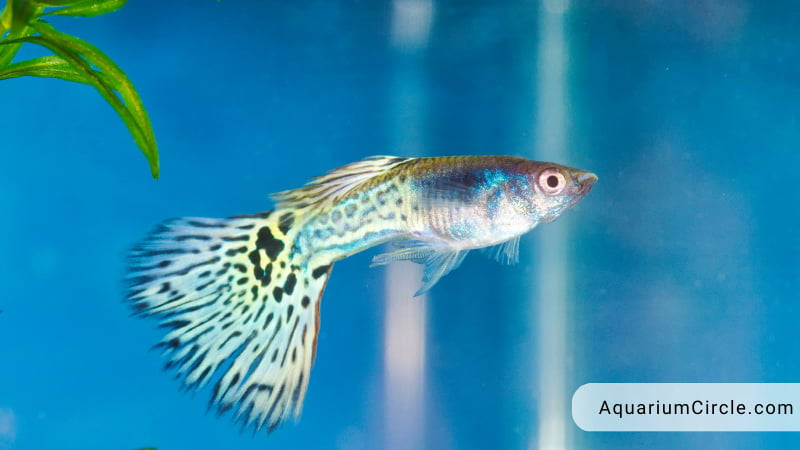
Let’s review the reasons why guppy fish may stop growing before we describe how to speed up the growth rate of guppies:
Aquarium space
Insufficient space can hinder the growth of guppy fish at any stage of development, be it during the fry, juvenile, or adult phase.
Adequate aquarium space is essential for guppies to thrive and grow. A 10-gallon tank is the recommended size for housing a starter pair of guppies or raising guppy fry.
However, if you plan to keep more than 3-5 guppies in your aquarium, or if you have the option to accommodate a larger tank, a 10-gallon starter aquarium may no longer suffice, and you’ll need to increase the tank size accordingly.
Water parameters
Water parameters, such as temperature, harmful gases, and oxygen levels, significantly impact guppy growth. It is crucial to remove waste and toxins from the aquarium daily and maintain optimal water conditions. Pregnant females are particularly sensitive to chilling, so installing a heater and filter system is essential. Regular water changes help maintain a pH of 7.0-8.0 and a temperature of 71-81°F (21-27°C).
Crowded tank
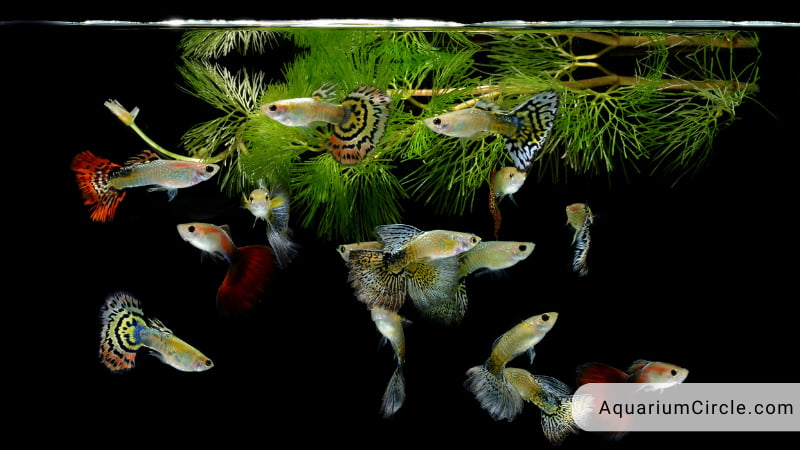
An overcrowded aquarium can undoubtedly stunt the growth of your fish and lead to various health issues, resulting from inadequate oxygen, elevated toxin levels, and the stress of a confined space.
Considering the high breeding rate of guppies, a small aquarium can easily become overcrowded. It’s essential to ensure your tank is spacious enough for the number of fish you’re keeping or consider rehoming some of them.
Additionally, maintaining an appropriate male-to-female ratio (1:3) and controlling the population by preventing breeding, such as keeping only male guppies, can help manage the tank’s population and reduce overcrowding.
See also: How Many Guppies In A 10 Gallon Tank? – 5 Things To Focus
Genetics
Genetics plays a vital role in determining the growth potential of your guppies. Guppy fish can be bred for various traits, including color, patterns, and size.
However, if the genetic makeup of your guppies does not favor the development of larger specimens, efforts to grow bigger guppy fish may prove unsuccessful.
Food
Providing high-quality, varied foods is crucial for ensuring that your fish receive the necessary nutrients, vitamins, and proteins needed for growth and a robust immune system capable of combating diseases.
Feeding your guppies exclusively with flake foods, regardless of quality, is not ideal. Instead, supplement their diet with frozen, freeze-dried alternatives, and even live foods, as long as they come from controlled environments.
Now that you understand the factors that can hinder guppy fish growth, let’s explore ways to enhance the growth rate of guppy fry and juveniles.
See also: How Often Do You Feed Guppy Fish? – Best Food For Guppy
How To Speed Up Guppy Growth Rate?
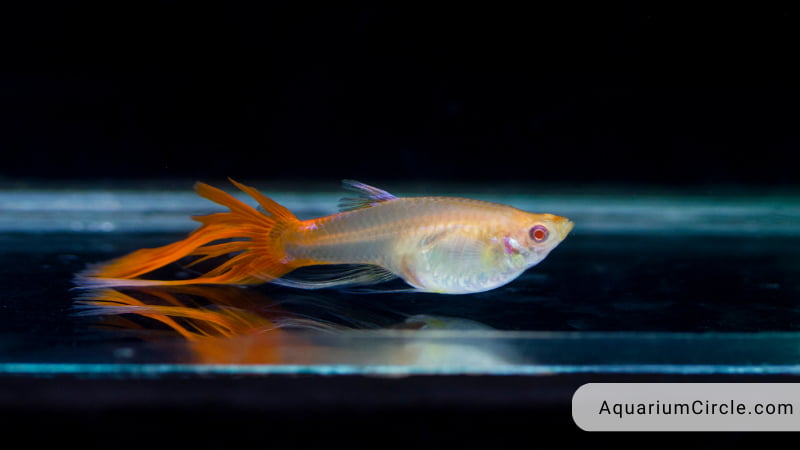
To speed up the growth rate of your guppy fish, you can follow these tips:
- Appropriate tank size: Ensure that your guppies have sufficient space to grow and swim by choosing an aquarium size that accommodates the number of fish you intend to keep. A 10-gallon tank is suitable for a starter pair or raising guppy fry, but consider a larger tank if you plan to house more fish.
- Maintain water quality: Regularly monitor and maintain optimal water parameters, including temperature, pH, and oxygen levels. Perform routine water changes to remove waste and toxins, and invest in a quality filtration system to keep the water clean and stable.
- Balanced diet: Offer your guppies a well-rounded diet consisting of high-quality flake foods, frozen and freeze-dried alternatives, and live foods from controlled environments. This variety ensures they receive essential nutrients, vitamins, and proteins for growth and immune system support.
- Proper lighting: Provide 8-10 hours of natural light per day to stimulate food intake and maintain good vision. Since guppies are diurnal creatures, they also require a period of darkness to rest and sleep.
- Monitor population: Control the population in your tank by maintaining an appropriate male-to-female ratio (1:3) and taking steps to prevent breeding, such as keeping only male guppies. This helps to avoid overcrowding, which can stunt growth and cause stress.
- Stress reduction: Minimize stressors in the tank environment, as stress can adversely affect guppy growth. Provide hiding spots and decorations to give your fish a sense of security, and avoid sudden changes in water parameters or tank conditions.
- Selective breeding: If you are interested in breeding guppies for specific traits, including size, choose specimens with the desired characteristics to encourage the production of larger offspring.
By following these tips, you can support the optimal growth and overall well-being of your guppy fish, helping them to thrive and reach their full potential.
Video About How Big Do Guppies Get
FAQs
What is the average size of a fully-grown guppy?
Adult guppies typically reach a size of 1.5 to 2.4 inches (3.8 to 6 cm), with males being smaller than females.
How long does it take for a guppy to reach its full size?
Guppies usually reach their full size within 4 to 6 months, depending on factors such as genetics, diet, and water quality.
Can guppies grow bigger in larger tanks?
While tank size can affect guppy growth, other factors like genetics and diet play a more significant role. However, overcrowding can stunt growth, so a suitable tank size is essential for optimal growth.
How do I know if my guppies are growing properly?
Monitor their size and overall health regularly. Healthy guppies should grow at a steady pace, display vibrant colors, and show no signs of illness or deformities.
How often should I feed my guppies for proper growth?
Guppies should be fed small amounts of food 2 to 3 times a day. Overfeeding can lead to health issues and poor water quality, which can negatively impact growth.
References

Annette M. Chaney is an experienced marine biologist with over 20 years of experience as an aquarist and fishkeeper. She started her first aquarium at a young age, filling it with frogs and goldfish obtained from the ten-cent pet store.
Annette grew up caring for and breeding African Cichlids, which led to a hobby in high school that doubled as a profitable means. Attending Reed College gave her time to solidify herself as an accomplished aquarium caretaker with an eye for sales. After that, from 2009 – 2013, she studied at Roger Williams University – one of the most prestigious universities for Aquaculture and Aquarium in USA. She is the founder of AquariumCircle since 2010.
